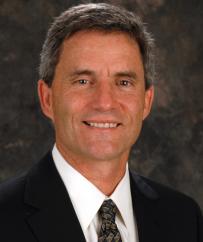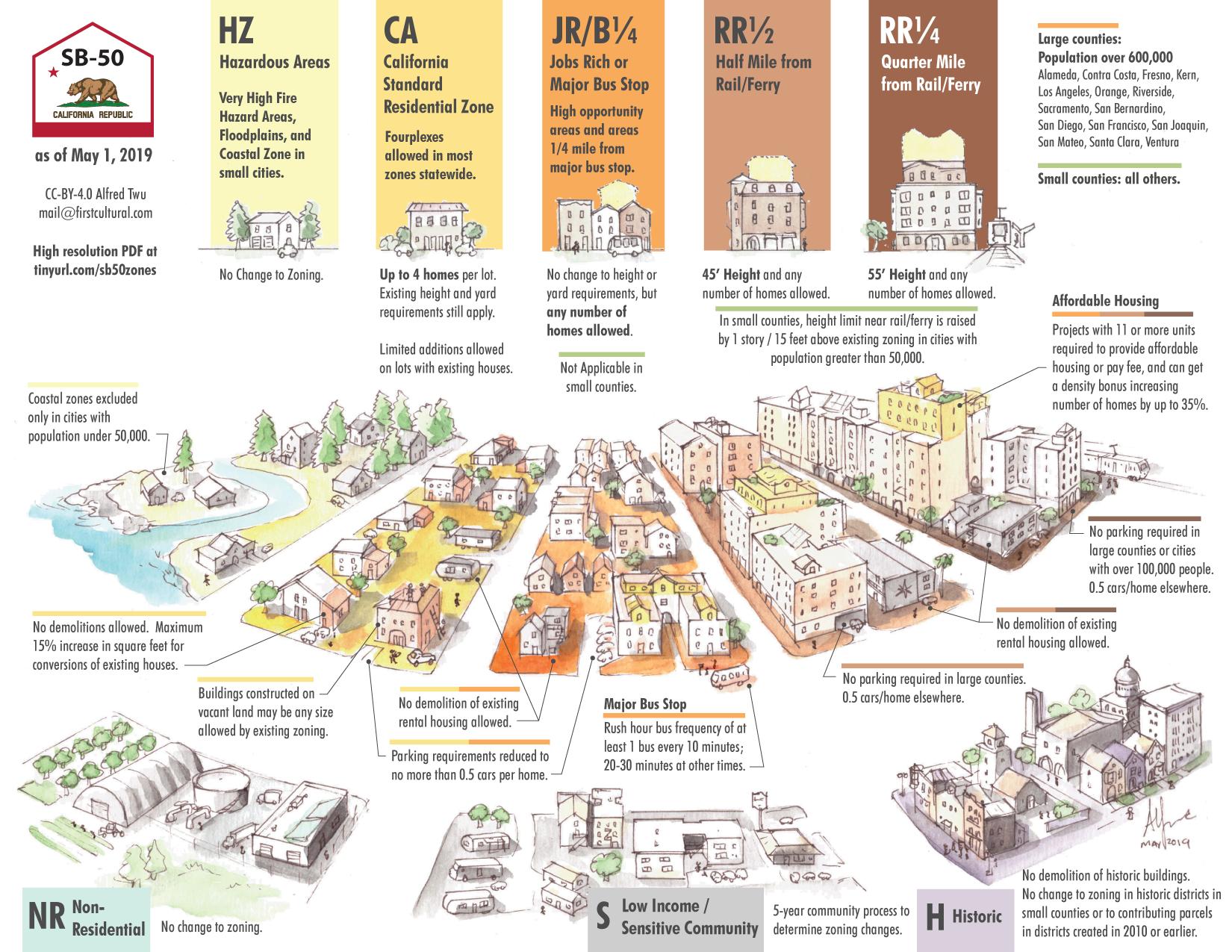The State Legislature’s transactional politics were on full display during the deliberation of Senator Wiener’s SB 50 and similar bills to strip local zoning and land use decisions from municipalities and, in the case of SB 50, allow any single family home within a quarter-mile of a bus stop to be rezoned for multifamily. Alarmed by what he sees happening in Sacramento, Redondo Beach Mayor Bill Brand discussed with TPR what’s at stake for local control when the State Capitol—lobbied heavily by both real estate and Silicon Valley tech interests—pushes a one-size-fits-all solution to California’s complex housing and affordability problems. Editor’s note: TPR has published several interviews in the past year which fault the supply-side arguments of the WIMBYs, including reference in UCLA Professor Storper’s TPR interview to a recent paper by Yonah Freemark at MIT that showed how upzoning in Chicago served to increase land values “because upzoning means that landowners can count on being able to construct more in the future. But what upzoning did not do in Chicago, and is not likely to do anywhere, is create incentives for housing construction in the areas where middle-class and lower-income people most need it for the prices at which they need it.”

Bill Brand
"SB 50 is probably the largest wealth transfer in the history of California to the developers, lawyers, and all the infrastructure behind them who are going to benefit from this." —Mayor Bill Brand
Mayor Brand, we last interviewed you a year ago about the potential impacts of an attempt by the state to override local land use and planning guidelines, which are embedded in more than a century of practice in California. Could you bring us up to date now that Senator Wiener’s SB 50, the successor to his proposal from last year (SB 827), is moving through the Legislature?
Bill Brand: What’s going on in Sacramento is absolutely out of control. There are more than 200 bills focused simply on rezoning and redeveloping much of the entire state, founded on the idea that we have a housing shortage and an affordability crisis—which is true in some areas, but not in others.
These bills are undoing how California cities have been operating for a really long time. Local communities are the best equipped to make tough development decisions in their individual towns. SB 50 is getting a lot of attention, but we can’t take our eye off the ball. From a local perspective, what’s happening with the 200 other bills in the Legislature right now could accomplish what SB 50 is trying to do—just with a piecemeal approach.
What was your reaction as you watched the state Senate’s Government and Finance Committee exempt certain cities and counties from SB 50 in exchange for committee votes?
It was unbelievable. Nobody has the time or the bandwidth to drill down on all the amendments—who’s included now and who’s not—because it never ends. With the stroke of a pen, whatever you think happened, could now be different. And that was just one bill.
I was in Sacramento on the day SB 50 was heard in committee, watching senators from Northern California basically horse-trade zoning and land use all over the state in order to get their pet bill through the process. All of California should be outraged to see such an important issue devolve into flagrant transactional politics between a couple of legislators representing one small section of the state.
What’s really disturbing is that affordable housing is a complex problem. Everybody’s trying to deal with it. SB 50 and bills like it are using exactly the wrong approach by taking up arms against local communities that are trying to address these complex problems. Unfortunately, it’s just a giant distraction to have to deal with this kind of sausage-making going on in Sacramento right now.
Let’s take a step back and talk about the city you represent as mayor. What are the characteristics of Redondo Beach’s current housing mix and economy that the greater state of California ought to be more aware of?
Redondo Beach has 11,000 residents per square mile, which is very dense. It’s denser than Long Beach, and it’s 2-3 times denser than many of the areas represented by the state legislators who are trying to increase density. We are actually a poster child for what they would like to see happen in a coastal community or in any city in California trying to deal with this housing crisis.
We have a tremendous amount of senior living in Redondo Beach. We have one-bedrooms, two-bedrooms, and three-bedrooms. We have a Section 8 program. We have a trailer park. We have people living on their boats. We have $10 million homes overlooking the ocean. We have it all. We’ve approved projects recently that include an affordability component.
From my perspective, Redondo Beach has done a fantastic job trying to keep up with demand for housing. Bills like SB 50 and other housing bills coming down from Sacramento seem to be punishing us for the great work that we’ve done.
Share Redondo Beach’s current development activity. What’s before the council with respect to the development of your beach city?
We just approved redevelopment of the South Bay Galleria, a 1.6 million-square-foot development. That includes 300 new apartment units, 20 percent of which are affordable (and we don’t even have an inclusionary zoning ordinance for affordable housing; we just mandated it for approval of the project). There’s office space and a hotel also included in that project. That is the largest project to be approved in the history of Redondo Beach.
We have a soon-to-be completed memory care facility right on Pacific Coast Highway two blocks from the beach with 100 beds. We’ve approved another redevelopment that has 115 units, also on Pacific Coast Highway. And we just opened another development of 50 units there as well. We’re also looking at redeveloping our waterfront and the 50-acre AES power plant site. So there’s actually a lot of development happening and being planned in Redondo Beach.
Currently, SB 50 would exempt transit-oriented developments from city approval, as well as from CEQA. It also establishes residential development waivers for projects located within a half-mile or quarter-mile radius of a bus corridor or major transit stop, respectively. How significant are these state preemptions given how cities are presently planned and served?
It’s extremely unusual; in fact, it’s never been done before. We’re talking about rezoning much of the state based on bus schedules, which could be changed with a stroke of a pen. A transportation agency could rezone your entire town by increasing the frequency of the bus. We’ve never heard of this as a way to decide how to properly develop a town. It’s anathema to proper city planning, which takes into consideration what’s necessary to create a livable community, whether in regard to public safety, schools, parks, or even our finances.
Preempting these decisions undermines the financial stability of a community. Most cities don’t generate much revenue from residential developments; some do, but some don’t. Redondo Beach only gets 17 percent of our property taxes back from the state, which does not pay for the services necessary to support residential development, like public safety and public works.
Part of the argument for SB 50 is that the state needs to incent more affordable housing, especially in coastal California and communities near Silicon Beach, where IPOs are creating new millionaires by the thousands who need housing. What should be the policy solution to encourage more supply, and more importantly, more affordable housing, especially considering there are no inclusionary zoning provisions in SB 50?
It must be noted that there are already state laws requiring affordable housing in the Coastal Zone; the California Coastal Act requires projects to include 10 percent affordable housing through the Mello Act. Some cities, like Redondo Beach, are also mandating more affordable housing when new residential development goes up.
But these are very complex problems that require local answers. We do not have a housing shortage in Redondo Beach, with 11,000 residents per square mile. However, we do have an affordable housing shortage.
What’s more of a challenge for us is our housing/jobs imbalance. Right now, 93 percent of Redondo Beach residents who work leave the city to go to work. If you add more housing in Redondo Beach, you’re just going to worsen that imbalance and make the morning and afternoon commutes much worse.
We need to bring more jobs here to better balance that out. In other areas of the state, there might be a different imbalance, and a need to bring more housing to the job centers in order to alleviate some of the pressure on transportation corridors. This one-size-fits-all broad brush from Sacramento is going to make the problems in many areas, such as ours, much worse.
In a TPR interview last year on Senator Wiener’s SB 827, former LA County Supervisor Zev Yaroslavsky said, “SB 827 is not a housing bill; it’s a real-estate bill. It is intended to monetize real estate. This bill is not about YIMBYs vs. NIMBYs; it’s about WIMBYs: Wall Street in My Backyard. With one stroke of the pen, the State Legislature could totally transform the economics of real-estate development in Los Angeles—while totally eviscerating decades of planning.” Was Zev correct?
Oh, absolutely. And actually, I use that acronym all the time: WIMBY. SB 50 is probably the largest wealth transfer in the history of California to the developers, lawyers, and all the infrastructure behind them who are going to benefit from this. It’s Christmas for them, and Scott Wiener is their Santa Claus. Local communities are the ones who are going to suffer.
Ultimately, this is all about money. The approach they’re taking really just creates a wealth transfer, and there’s a lot of big money behind it trying to push it through. In fact, it should be up to the local communities, whether it’s a city as big as LA or as small as Redondo Beach, to look out for what’s in the best interest for their residents. I think we’re seeing that now as local communities are finally rising up and realizing the damage that Sacramento will inflict on their towns.
As you follow SB 50 and like state legislation under consideration, how do you expect local government will respond?
We’re working on a statewide initiative with activists, housing advocates, and local officials across Northern and Southern California to get a constitutional amendment on the November 2020 ballot to make zoning and land use a municipal affair. We’re looking to submit that to the Attorney General soon for title and summary, and then begin the huge fundraising effort for the more than $5 million we’ll need just to get the initiative on the ballot.
If you succeed in qualifying a ballot measure that would protect and restore the power of local government over land use and zoning, won’t the WIMBYs have a lot of money and resources to oppose a measure supported by tenants’ rights groups, neighborhood and historic preservation advocates, and local governments?
Yeah, I’m sure they will. They will probably outspend us 10-1. That doesn’t mean we’re not going to win. As people begin to better understand what’s at stake here—that quality of life and the ability to deal with these difficult problems are on the line—I think the public will come around to our side regardless of the messaging the other side crafts. But yeah, this is going to be a war.
Click here to expand the image. This infographic by artist Alfred Twu illustrates the impact of SB 50, as amended, throughout California.
- Log in to post comments




